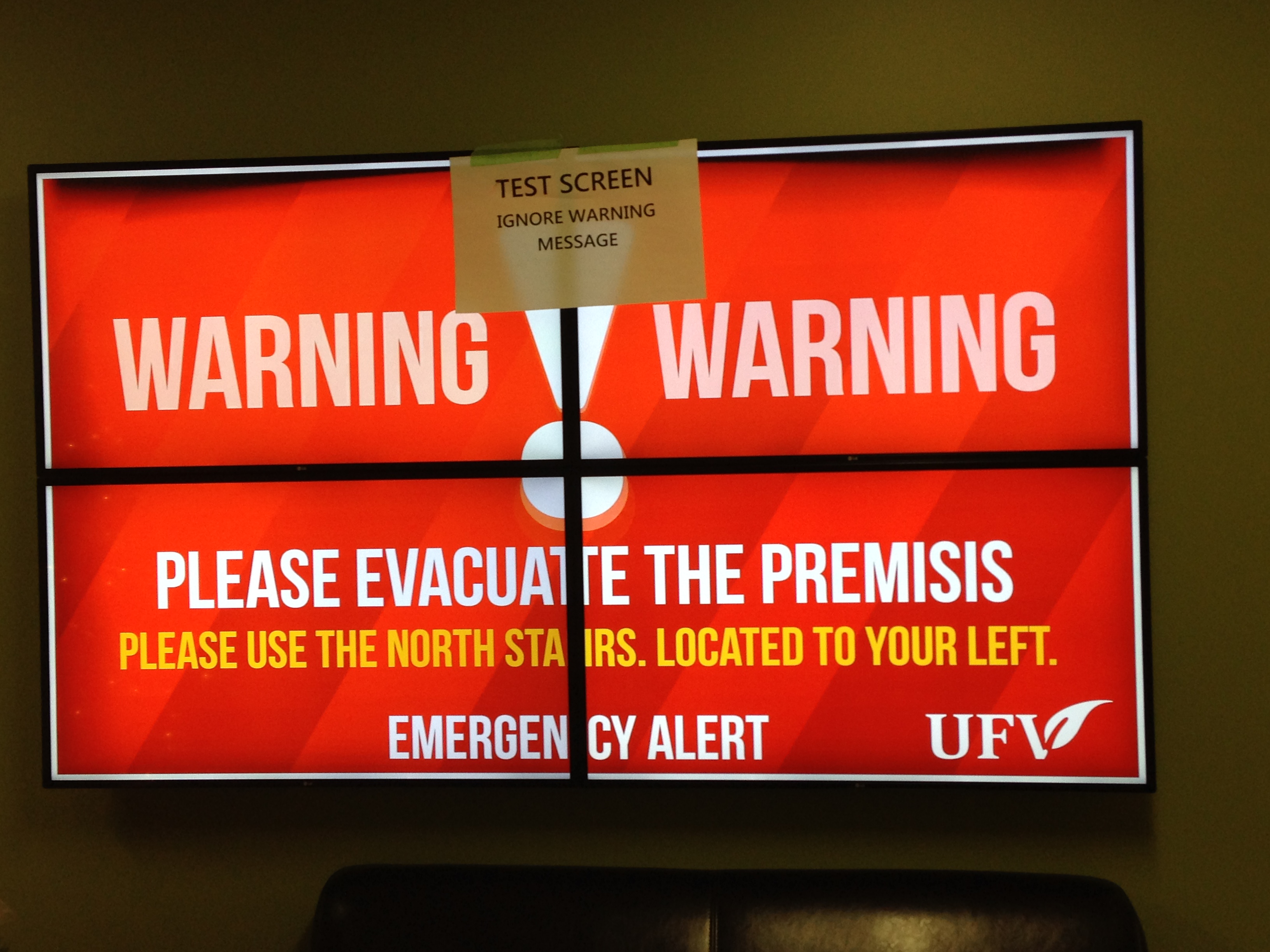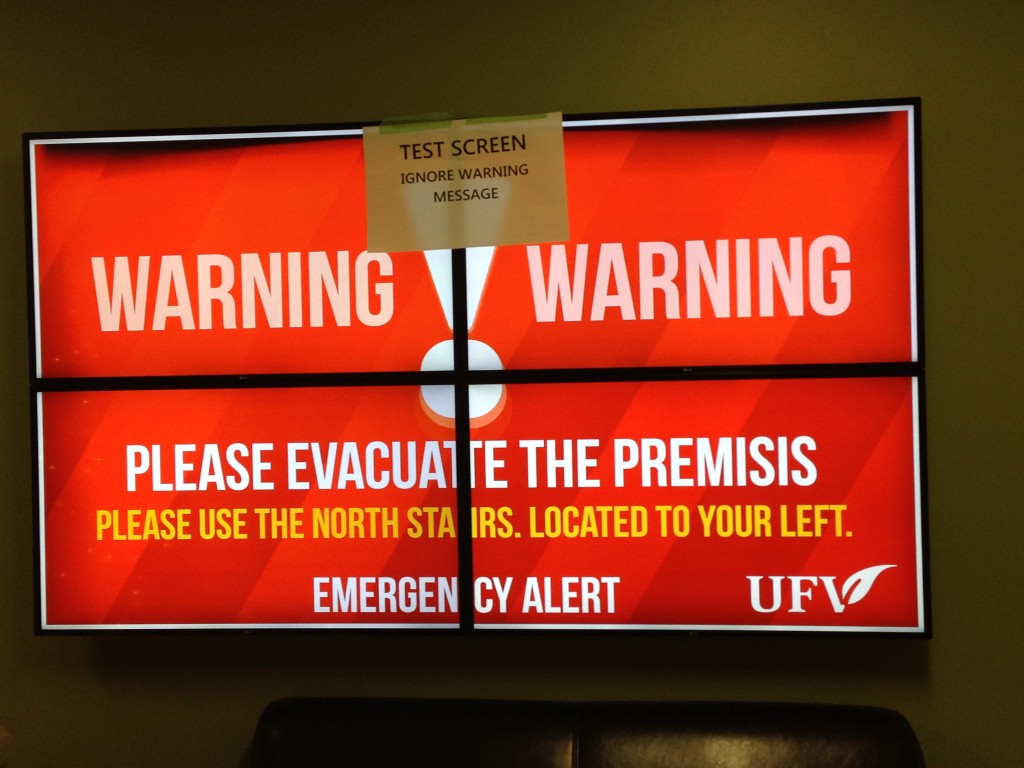By Valerie Franklin (The Cascade) – Email
Anyone walking past the Facilities office in room B150 in recent weeks may have been surprised to see a bright red television screen warning them to evacuate the premises — and a paper sign taped to the screen, reassuring them that the screen is only a test. But similar screens may soon spread word to students in the case of campus emergencies or closures as an important step in improving the university’s safety and emergency preparedness.
Mark Goudsblom, director of facilities management at UFV, explains that although the current screen is only a mock-up, these displays would allow for the broadcast of emergency notifications in situations such as inclement weather, fire, natural disasters, and safety drills, as well as giving students information about the nature of the emergency.
“They would allow us to reach out to students in different buildings if activities occur in another,” says Goudsblom. “So if we have a fire in building B, the emergency signage could show that there’s a fire in building B [with a message saying] ‘Please evacuate,’ or ‘Do not access.’”
Goudsblom explains that as part of its regular annual maintenance, the university receives money from the Ministry of Advanced Education to improve its infrastructure and systems as well as life safety and accessibility, based on reports about what needs to be renewed or replaced. Several years ago Facilities identified that the fire alarm system in UFV’s older buildings was due to be upgraded, and put a proposal forward to the Ministry to upgrade all of the fire alarm systems throughout the university, putting them on par with the fire alarm systems in newer buildings like the CEP campus or the Student Union Building. During that process other potential safety upgrades were also identified, such as enabling building access with cards.
“We amalgamated all of that into a very large proposal and put that forward to the Ministry and got a three-year funding for the project, and we’re now into the second year of that project,” says Goudsblom. He explains that because the funding is year-to-year, there’s no guarantee the university will receive its third year of funding from the Ministry; however, if it does, the university will look at implementing this digital signage in key areas such as stairways, hallways, and the Alumni Hall.
Many of the safety upgrades from the first two years of Ministry funding have been installed or will soon be complete.The first two phases of the upgrading project have focused on upgrading hardware such as locks, keys, doors, fobs, and alarms. This includes replacing the old red fire-alarm bells with speakers and strobe lights, which ensure that hearing-impaired individuals are alerted in an emergency. The plan to install emergency notification screens across the university will add another visual component to the warning system in addition to the strobe lights, as well as potentially offering students instructions on how to proceed and where to go. However, since the Ministry hasn’t confirmed that UFV will receive its third year of funding, the details of what the notification system will broadcast have not yet been decided.
As another part of the upgrading initiative, the university is in the process of implementing an auditory broadcast system throughout its campuses, which Goudsblom says will be complete by the end of March 2016. In the case of an emergency, this system will allow Security to pick up a microphone and make announcements throughout all buildings.
“It would also allow for standardized notifications,” Goudsblom explains, “so you can actually push a button and it will have an audible sentence: ‘There’s a fire in your building, please evacuate,’ or, ‘This is a fire drill.’” He adds that there are currently 10 such pre-recorded messages in the system for a variety of situations including fire and earthquake scenarios.
Brian Leonard, director of security and emergency management, says that the proposed emergency notification screens would also be compatible with the mobile UFV Alert app, which currently transmits similar messages about campus closures to students who have downloaded it. Making the emergency notification screens compatible with the UFV Alert app means that if a student were to miss an emergency broadcast over the announcement system, they would still catch it as a message on their phone.
“There’s 1,300 people out there who have that kind of notification on their mobile device, and they could be in classrooms, they could be in hallways and corridors,” says Goudsblom. Considering there are about 15,000 students currently at UFV, this makes it almost one in 10 students in different classes and areas who have the ability to share emergency alerts and information with other people directly around them.
“If we marry that with the digital screens and the overhead enunciation, and then combine that with some information that goes out through UFV Alert, and then the website, I think it makes for a very comprehensive response to any emergency situation,” he says.
When not being used for emergency broadcasts, the digital notification screens could also broadcast different kinds of information depending on their locations.
“If that screen was in Campus Card, all the students that would be lining up at the beginning of the year to get their cards could be seeing information on that digital screen that would be particular to the campus card — what they need to do, what they need to have ready,” says Goudsblom. “If we have one of those, for example, in the library, that screen, outside of being used for emergency notification, would then run information pertaining to what’s in the library.” Ideally, he adds, different departments and offices would be able to access the system and put their own information in it instead of having that done centrally.
“Those are the wishlists — those are the things we want to work on as we get into the actuals,” explains Goudsblom.
An important detail that Goudsblom and the other planners are considering is the potential connectivity of this notification system with existing systems and screens throughout the university.
“The Student Union Society has put in some digital screens in their Student Union Building, and one of the things is that we could actually connect with their system and allow the emergency broadcast to be pushed out into their screens as well,” says Goudsblom. He suggests that the emergency screens could even find a use in the shuttle bus.
“A good example for that is if we have some kind of screen in the shuttle bus, say inclement weather hits Chilliwack first before Abbotsford, we would be able to say to people on the bus, ‘Don’t go to Chilliwack, Chilliwack campus is closing in a half an hour due to an incoming snowstorm,’” says Goudsblom. “So you’d be able to connect with people, in this case students, faculty, and staff, en route.”
According to Leonard, similar notification systems are employed by BCIT and Kwantlen. He notes that while many people may envision the screens being used mainly for dramatic disaster scenarios such as a catastrophic earthquake or an intruder on campus, one of the main uses of the proposed screens will be sending messages about weather warnings and weather-related campus closures.
“If we talk just about weather, [the screens] will pay dividends with the ability to say, ‘In one hour, the campus is closing.’ Or even getting information from outside saying, ‘[Hwy 1] between A road and B road is closed,’” he says. He adds that weather has the greatest impact annually on the university in terms of business continuity.
However, whether the emergency notification screens will become part of UFV’s emergency preparedness system all depends on whether the funding from the Ministry comes through for the third and final year of the project. Goudsblom says that if it does, a working group that includes Security, Facilities, Marketing and Communications, Information Technology Services, Educational Technology Services, and Campus Planning will come together and determine what the details of the system should look like.
“Once the ministry gives us the final dollars, then we’re going to probably sit down as a working group again and move forward with putting out the RFI [a request for information from the industry about costs],” says Goudsblom.
Then it’s a matter of determining which companies will provide the services, and how those expenses will fit into the budget from the Ministry. Thus far the university has received about 1.8 million dollars for life safety improvements, which Goudsblom says has gone towards improving accessibility and fire safety. Additionally, the university is required to make a financial contribution toward its own upgrades.
When will the third phase of these security upgrades, such as the emergency notification screens, be implemented? That all depends on the money.
“We’ve put in a request, we’re in the third year of the project; I’m very hopeful, I keep my fingers crossed, but … it’s not entirely within our control,” says Goudsblom. “But we do all the work we can to prepare ourselves for having that money available.”



